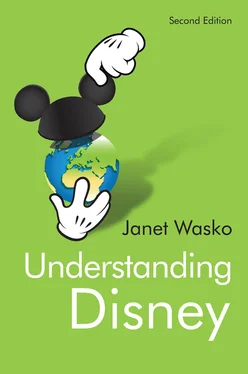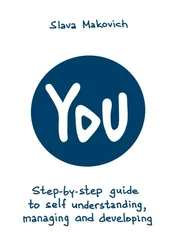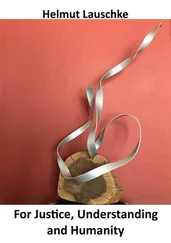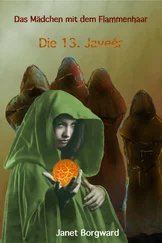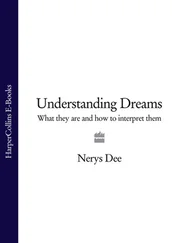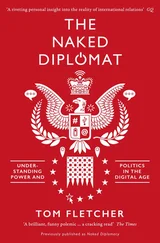Walt joined his brother Roy in Los Angeles in 1923, as an official history distributed by the Disney company explains, “with a lot of hopes but little else.” After failing to gain employment with one of the film studios, Disney started where he had left off in Kansas City by reviving the Alice series. After a New York company agreed to distribute the cartoons, Walt convinced Roy to become his business manager, and the Disney company was officially formed on October 16, 1923. Although at first the company was called the Disney Brothers Cartoon Studio, it soon became the Walt Disney Studio, reflecting the roles that the two brothers would play throughout the history of the company – Walt as the primary, “creative” force, who received the public attention and acclaim, and Roy, who worked behind the scenes, handling finances and tending to the organization. 14
While the studio produced 56 Alice shorts, another animated series based on a character called Oswald, the Lucky Rabbit, was created in 1927 for Universal Pictures. However, after brief success with ten Oswald shorts in 1927 and 16 in 1928, the Disney brothers discovered that the rights to the character were actually owned by Universal. In addition, the majority of his animators had been lured away from the Disney company to work for the New York distributor. This story is an oft-repeated one in the Disney legend, as it was said to have taught Walt an important lesson: never lose control of your creations. Any number of events in Walt’s life and in the Disney histories are explained by this one story.
“It all started with a mouse”
What followed the loss of Oswald also became part of the Disney legend: the birth of Mickey Mouse. The most famous version of the story features Disney and his wife (whom he had first employed at his studio and then married in 1925) traveling by train from New York after learning that Oswald had been lost. Disney created Mickey, at first called Mortimer, and returned to Hollywood with the first cartoon in mind. It is amazing how often this story is repeated.
Another version is presented by one of the official histories distributed by the company: “It was at the Hyperion Studio, after the loss of Oswald, that Walt had to come up with a new character, and that character was Mickey Mouse. With his chief animator, Ub Iwerks, Walt designed the famous mouse.” 15The more careful biographies agree that the creation of The Mouse (as he is referred to around the Disney studio) was a collaboration between Disney and Iwerks; however, Disney took the credit in public. Iwerks animated two cartoons featuring the new character, Plane Crazy and Gallopin’ Gaucho . Yet the first Mickey Mouse cartoon released was actually the third film produced. Steamboat Willie appeared in November 1928 after synchronized sound had been added. Many of the Disney histories credit the addition of sound to Walt, after he viewed the first feature film with sound, The Jazz Singer , in 1927. However, another version of the story is that he was “unable to sell (the cartoons) because they were silent films, and sound was revolutionizing the movie industry.” 16
What is indisputable is that Mickey Mouse was an instant success, not only with distributors and theater owners but also with the public. In his controversial biography of Disney, Marc Eliot notes that there were more sophisticated animated shorts being made at the time. “However, what set Disney’s films apart was his ability to produce cartoons that not only talked but made lots of money, and that combination made them highly desirable to the industry’s leading distributors.” 17The Disney company was able to secure a distribution contract with Columbia Pictures to produce additional Mickey Mouse cartoons, even though the amount received often did not cover the costs, which by late 1931 had increased from about $5,400 to $13,500 for each cartoon. 18
Thus the Disney brothers found that they needed additional revenue to survive and turned to other sources, especially merchandising (Figure 2.2). The first arrangement to produce a Mickey Mouse product was a $300 offer to feature The Mouse on writing tablets in 1929, but it was quickly followed by many more. The first formal merchandising contract was with the George Borgfeldt Company in 1930, although apparently there was also a good deal of unlicensed merchandise, especially in Germany, France, England, Italy, Czechoslovakia, and Spain. 19In 1932, the company hired a dynamic salesman and innovator, Herman “Kay” Kamen, to head the merchandising division, leading to a proliferation of Disney products. An indication of the growing importance of merchandising for the company was the reorganization in late 1929 into four divisions: production, film recording, real estate, and licensing and merchandising (later called Walt Disney Enterprises). 20
Early Mickey Mouse products were mostly toys and dolls but subsequently expanded to every imaginable kind of product. Especially popular were watches and clocks produced by the Ingersoll–Waterbury Company. By January 1930, Mickey appeared in a comic strip distributed by King Features. Mickey and his friends were also featured in Mickey Mouse Magazine (from 1933 to 1940) and numerous books, as well as in a newspaper comic strip. Similar publications appeared in other countries, as Mickey was featured as Topolino in Italy and in Le Journal de Mickey in France.
Even before the merchandising efforts, Mickey Mouse Clubs had appeared around the country and the world, organized around Saturday movie matinees for children. The company distributed bulletins to theaters explaining how to start clubs in their towns. By 1932, there were a million members worldwide of the Mickey Mouse Clubs, which also served to promote the Disney cartoons and merchandise. 21

Figure 2.2: Mickey Memorabilia displayed at D23 Expo 2011. Photo from Disney Treasury Archives by Doug Kline.
With the success of Mickey Mouse, the studio began production of the Silly Symphonies , a series of short films that experimented with sound, music, and images to create moods and emotions, rather than humor as in other Disney productions. The first of the Silly Symphonies was The Skeleton Dance in 1929, followed by Frolicking Fish , Monkey Melodies , and Arctic Antics . Disney was one of the first companies to use Technicolor’s color process, producing the first full-color cartoon, Flowers and Trees , a Silly Symphony that won the Academy Award for the Best Cartoon for 1932. 22Another of the Silly Symphonies that attracted special attention was the Disney version of The Three Little Pigs , released in 1933. The film not only grossed approximately $125,000 during its first year of release but also became a national sensation.
Other characters emerged from the company’s films to become part of the Classic Disney stable, including Minnie Mouse, Mickey’s dog Pluto, Goofy, and, to a lesser extent, Clarabelle Cow, Horace Horsecollar, and the villain Pegleg Pete. Donald Duck appeared in one of the Silly Symphonies in 1934 and became one of the company’s most popular characters, with his own line of merchandise, including Donald Duck bread, Donald Duck peanut butter, and Donald Duck orange juice.
By 1934, the company employed about 200 people at its Hyperion Avenue location, which was continually expanding with the addition of offices, stages, and labs. By all accounts, the company had become successful.
Читать дальше
